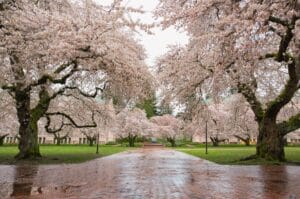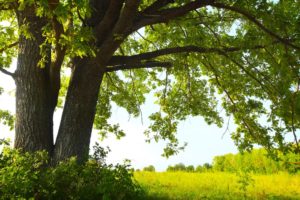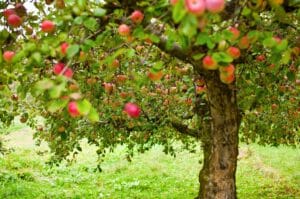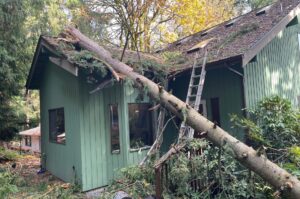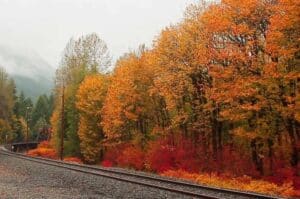Top 5 Spring-Flowering Trees for Seattle
Is there anything more beautiful than a flowering tree in the spring? We can think of something – a flowering tree of your own! We obviously love trees at Seattle Tree Care, and that’s why we’re pleased to present you with our recommendations for our favorite spring-flowering trees to plant in your Seattle yard.
Whether you’re looking for deep purples, delicate whites, vibrant yellows, or pale pinks, there’s sure to be something here you’d love to add to your property.
Read on for specifics on each recommendation’s size, preferred growing conditions, pest and disease considerations, and more!
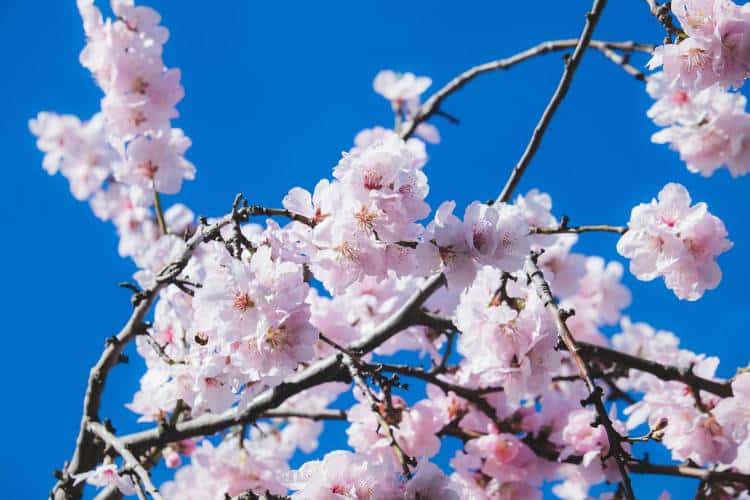
1. Yoshino Cherry Tree (Prunus x yedoensis)
The first tree on our list is the Yoshino Cherry. If these trees sound familiar, you may have seen the 90-year-old ones growing in the University of Washington Quad. These trees bring in crowds of people every spring to enjoy the beautiful rosy blooms.
These trees’ white to pale pink flowers are a beautiful sight in the early spring, but they last only 2-3 weeks, so you better appreciate them while you have the chance!
You may wonder if the Yoshino cherry tree provides fruit. The answer is “yes,” but though they are non-toxic and enjoyed by birds, they aren’t very tasty by human standards.
About the Yoshino Cherry
- Mature Size – 40-60 feet tall with a 25-40 foot wide canopy
- Preferred Growing Condition – Full sun (at least 6 hours of unfiltered sunlight per day)
- Native Range – The Yoshino cherry is native to Japan but grows very well in our climate
- Pest and Disease Issues – Aphids, scale, borers, caterpillars, Japanese beetles, powdery mildew
Interested in learning more about the beautiful Yoshino Cherry? Check out this video highlighting this gorgeous tree blooming in the spring.
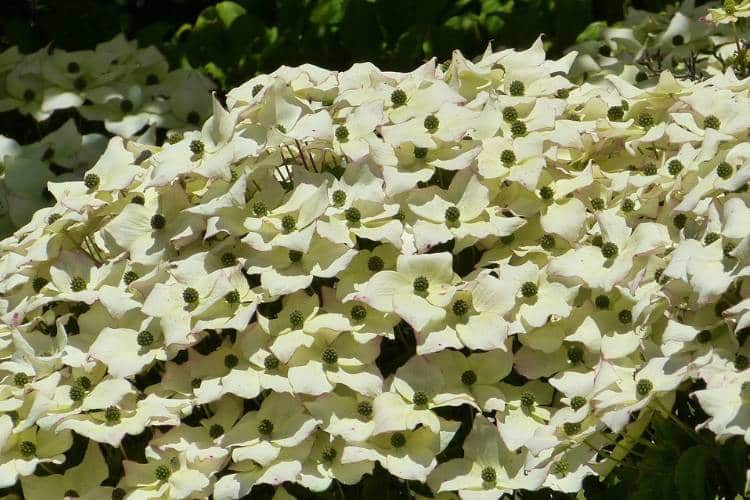
2. Kousa Dogwood (Cornus kousa)
Next up is the Kousa dogwood. This tree is a beautiful late-spring bloomer with attractive four-petalled bracts surrounding its green-yellow flowers.
You can expect to see this tree flowering in May to June (about a month later than other dogwood species), showing off its flowers against a backdrop of dark green leaves. This shorter tree is safe to plant carefully near overhead utility lines and isn’t considered a “messy tree,” so you won’t be doing a lot of raking when it drops its blossoms.
Be aware the Kousa dogwood is susceptible to a disease called dogwood anthracnose, although less so than the flowering dogwood (Cornus florida) that’s native to the USA. If this concerns you, an arborist from Seattle Tree Care can assess your trees and even provide an appropriate treatment if necessary.
About the Kousa Dogwood
- Mature Size – 15-25 feet tall with a mature canopy width of 25 feet
- Preferred Growing Conditions – Prefers average moisture but shows some drought resistance; full sun to partial shade
- Native Range – Japan, China, Korea, and other Asian countries
- Pest and Disease Issues – Susceptible to leaf and flower blight, shows more resistance to anthracnose and powdery mildew than the native variety
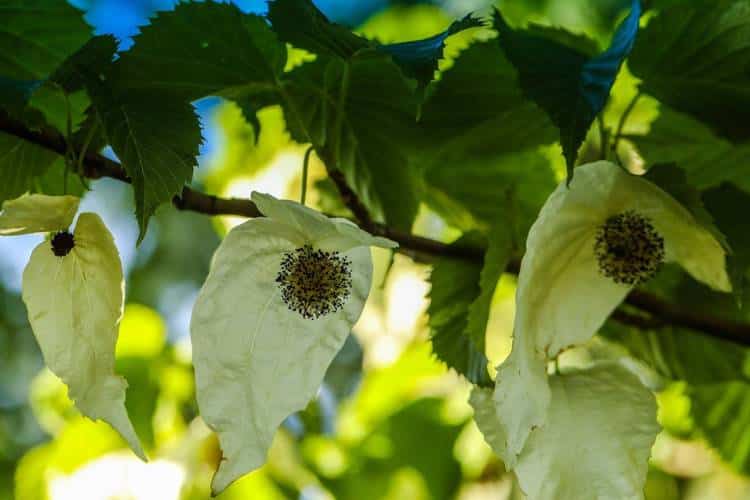
3. Dove Tree (Davidia involucrata)
We continue our best flowering trees for Seattle list with the dove tree. The dove tree is a perfect match if you’re looking for a flowering tree with unique, late-blooming flowers.
Also called the “handkerchief tree,” the paper-like flowers of this tree start out green and turn to white as the flowers mature. The dove tree does drop seed pods, making it a bit messy if planted near a sidewalk or patio.
The dove tree is moderately drought tolerant and does best in partial sun. This tree grows 20-60 feet tall, so don’t plant it under any overhead wires.
About the Dove Tree
- Mature Size – Wide size range, 20-60 feet tall with 18–36 foot wide canopy
- Preferred Growing Conditions – Prefers moderate temperatures, moist but well-drained soil, and full sun to partial shade
- Native Range – Southwestern China
- Pest and Disease Issues – No known pest or disease problems
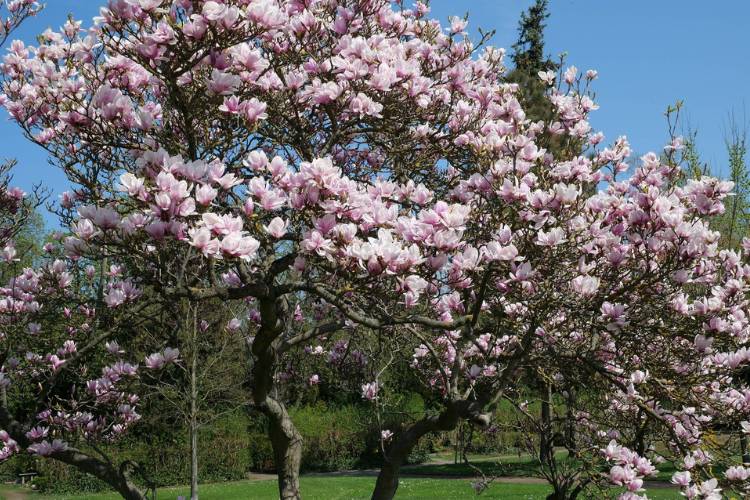
4. Yulan Magnolia (Magnolia denudata)
The Yulan magnolia tree has some of the most exciting and beautiful flowers on this list. Flowering in late winter to early spring, these trees exude a rich lemony fragrance.
Yulan magnolia trees are considered symbols of purity and have been grown in Buddhist temples in China for more than 1500 years. As the flowers bloom, they can resemble birds, making them incredibly unique and eye-catching.
Be aware that the Yulan magnolia tree has a low drought tolerance, so you must water it regularly. This tree does best in full sun.
And keep in mind that the Yulan magnolia is a tall tree, so you don’t want to plant them near utility lines.
About the Yulan Magnolia
- Mature Size – 30-40 feet tall with a 30-40 foot wide canopy
- Preferred Growing Conditions – Plant in moist soil, full sun to part shade, and protected from harsh winds
- Native Range – Eastern and Southern China
- Pest and Disease Issues – No major pest issues can develop Magnolia scale
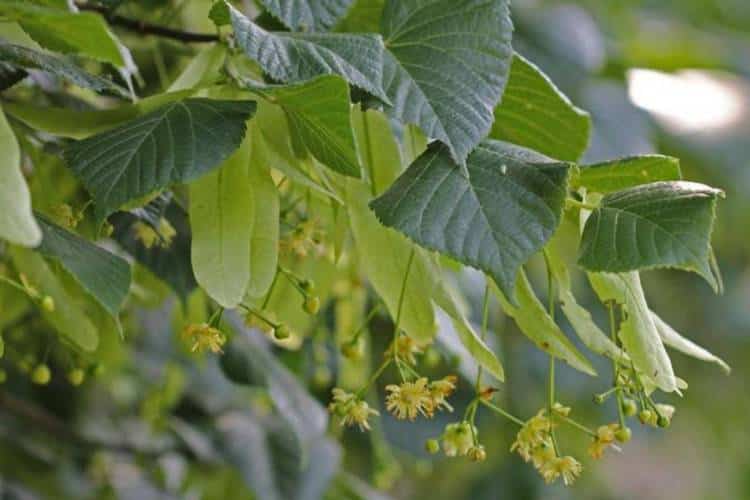
Small yellow littleleaf linden flowers hang from long thin stems among the tree’s green leaves. Photo courtesy of Rob Routledge, Sault College, Bugwood.org
5. DeGroot Littleleaf Linden (Tilia cordata ‘DeGroot’)
Last but certainly not least is the DeGroot littleleaf linden. If you like flowers but prefer something less showy, this is an ideal choice to plant in your yard.
These late-blooming trees’ fragrant flowers appear in late June to July and will attract plenty of beneficial honeybees. The DeGroot littleleaf linden grows at a moderate rate and remains more compact than other lindens, so is safe to plant along streets and near overhead utility lines. It has a pleasing pyramidal shape with a dense branching structure, making it a good shade tree.
About the DeGroot Littleleaf Linden
- Mature Size – 35-40 feet tall with a canopy width of about 20 feet
- Preferred Growing Conditions – Moist, but not overly wet soil; minimum of 4 hours of unfiltered sunlight per day
- Native Range – Western Siberia and Iran
- Pest and Disease Issues – Mites, aphids, leaf miners, Japanese beetles, verticillium wilt, leaf blight
What’s the Right Spring-Flowering Tree for You?
Whatever flowering tree you choose for your yard, it’s important to consider the tree’s preferred growing conditions, mature size, and planting location, as well as how much maintenance the tree may need to remain healthy and aesthetically pleasing.
We have to stress that you should avoid planting trees that will grow to a large size near powerlines, houses, and other structures. The last thing you need is for your new tree to tear off your gutters, damage your roof, or create an electrocution hazard.
Also, consider what utilities may be underground before you plant. If you don’t, you could end up with roots wrapping around plumbing and underground wires. If you’re unsure about what’s underground in your yard, contact the Washington Utilities and Transportation Commission by dialing 811 to have any underground utilities identified and marked prior to planting.
Need Help Choosing a Tree?
If you’d like help determining what flowering tree is best for your Seattle yard, give us a call! Seattle Tree Care’s certified arborists will start by thoroughly evaluating your property to help you make the right choice. We’ll consider things like soil type, available space, irrigation needs, and the maintenance required, as well as your preferences for color, bloom time, and overall appearance. Taken together, all of that information will allow us to provide the best tree recommendations for you.
Call us today at 206-789-0534 or fill out our convenient online form, and we’ll get back to you ASAP – usually within 24 hours!
Recent Articles
SEE MORE ARTICLES FROM OUR b(LOG)
Looking for More?
We've got you covered with tips, resources, updates, how-to's, and other helpful information about trees and landscapes in Seattle, Puget Sound, and King County, WA. Join the thousands of smart local residents who get the monthly newsletter from Seattle Tree Care for helpful information you won't want to miss!
There's no spam - we promise! We are committed to keeping your e-mail address confidential. We do not sell, rent, or lease our contact data or lists to third parties.


